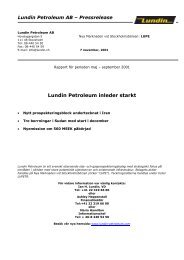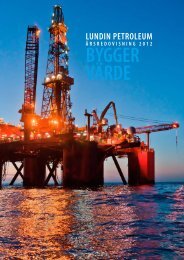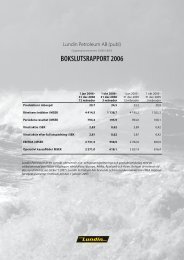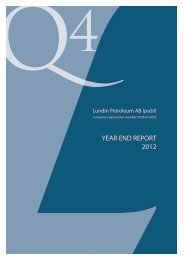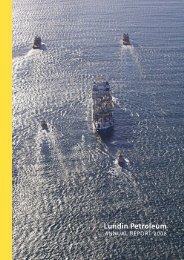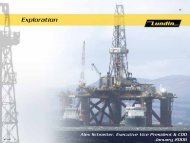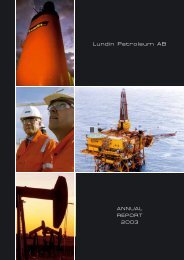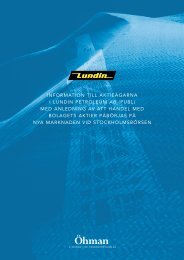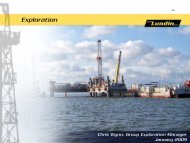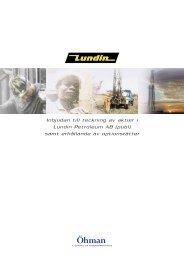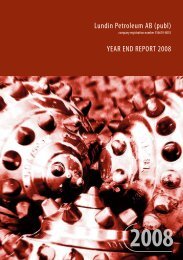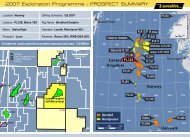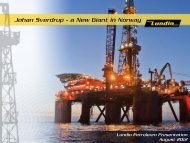Annual Report 2005 (6 MB) - Lundin Petroleum
Annual Report 2005 (6 MB) - Lundin Petroleum
Annual Report 2005 (6 MB) - Lundin Petroleum
You also want an ePaper? Increase the reach of your titles
YUMPU automatically turns print PDFs into web optimized ePapers that Google loves.
ACCOUNTING PRINCIPLES<br />
The Group categorises derivatives as follows:<br />
1. Fair value hedge<br />
Changes in the fair value of derivatives that qualify as fair value<br />
hedging instruments are recorded in the income statement,<br />
together with any changes in the fair value of the hedged asset<br />
or liability.<br />
2. Cash fl ow hedge<br />
The eff ective portion of changes in the fair value of derivatives<br />
that qualify as cash fl ow hedges are recognised in shareholders´<br />
equity. The gain or loss relating to the ineff ective portion is<br />
recognised immediately in the income statement. Amounts<br />
accumulated in shareholders´ equity are transferred to the<br />
income statement in the period when the hedged item will<br />
aff ect the income statement. When a hedging instrument no<br />
longer meets the requirements for hedge accounting, expires or<br />
is sold, any accumulated gain or loss recognised in shareholders´<br />
equity is transferred to the income statement when the forecast<br />
transaction is ultimately recognised in the income statement.<br />
When a forecast transaction is no longer expected to occur,<br />
the accumulated gain or loss reported in equity is immediately<br />
transferred to the income statement.<br />
3. Net investment hedge<br />
Hedges of net investments in foreign operations are accounted<br />
for in a similar manner as cash fl ow hedges. The gain or loss<br />
accumulated in equity is transferred to the income statement at<br />
the time the foreign operation is disposed of.<br />
4. Derivatives that do no qualify for hedge accounting<br />
When derivatives do not qualify for hedge accounting,<br />
changes in fair value are recognised immediately in the income<br />
statement.<br />
Restricted cash<br />
Restricted cash represents cash amounts that have a conditional<br />
restriction on their withdrawal and are shown as a fi nancial fi xed<br />
asset in the balance sheet.<br />
Inventories<br />
Inventories of consumable well supplies are stated at the lower<br />
of cost and net realisable value, cost being determined on a fi rst<br />
in fi rst out (FIFO) basis. Inventories of hydrocarbons are stated at<br />
the lower of cost and net realisable value. Under- or overlifted<br />
positions of hydrocarbons are valued at market prices prevailing<br />
at the balance sheet date. An underlift of production from a fi eld<br />
is included in the current receivables and valued at the reporting<br />
date spot price or prevailing contract price and an overlift of<br />
production from a fi eld is included in the current liabilities and<br />
valued at the reporting date spot price or prevailing contract<br />
price.<br />
Cash and Bank<br />
Cash and bank includes cash at bank, cash in hand and highly<br />
liquid interest bearing securities with original maturities of three<br />
months or less.<br />
Equity<br />
Share capital consists of the registered share capital for the<br />
parent company. Share issue costs associated with the issuance of<br />
new equity are treated as a direct reduction of proceeds. Excess<br />
> 54 <<br />
contribution in relation to the issuance of shares is accounted for<br />
in the item Additional paid-in-capital.<br />
The change in fair value of shares and participations is accounted<br />
for in the fair value reserve. Upon the crystallisation of a change in<br />
value, the change in fair value recorded will be transferred to the<br />
income statement. The change in fair value of hedging instruments<br />
is accounted for in the hedge reserve. Upon settlement of the<br />
hedge instrument, the change in fair value is transferred to the<br />
income statement. The currency translation reserve contains<br />
unrealised translation diff erences due to the conversion of the<br />
functional currencies into the reporting currency.<br />
Retained earnings contain the accumulated results attributable to<br />
the shareholders of the parent company.<br />
Provisions<br />
A provision is reported when the company has a formal or informal<br />
obligation as a consequence of an event and when it is more likely<br />
than not that an outfl ow of resources is required to settle the<br />
obligation and a reliable estimate can be made of the amount.<br />
On fi elds where the Group is required to contribute to site<br />
restoration costs, a provision is created to recognise the future<br />
liability. At the date of acquisition of the fi eld or at fi rst production,<br />
an asset, as part of oil and gas properties, is created to represent<br />
the discounted value of the anticipated site restoration liability<br />
and depleted over the life of the fi eld on a unit of production<br />
basis. The corresponding accounting entry to the creation of the<br />
asset recognises the discounted value of the future liability. The<br />
discount applied to the anticipated site restoration liability is<br />
subsequently released over the life of the fi eld and is charged to<br />
fi nancial expenses. Changes in site restoration costs and reserves<br />
are treated prospectively.<br />
Revenue<br />
Revenues from the sale of oil and gas are recognised in the income<br />
statement net of royalties taken in kind. Sales of oil and gas are<br />
recognised upon delivery of products and customer acceptance<br />
or on performance of services. Incidental revenues from the<br />
production of oil and gas are off set against capitalised costs of the<br />
related cost centre until quantities of proven and probable reserves<br />
are determined and commercial production has commenced.<br />
Service income, generated by providing technical and<br />
management services to joint ventures, is recognised as other<br />
income.<br />
The fi scal regime in the area of operations defi nes whether<br />
royalties are payable in cash or in kind. Royalties payable in cash<br />
are accrued in the accounting period in which the liability arises.<br />
Royalties taken in kind are subtracted from production for the<br />
period to which they relate.<br />
Borrowing costs<br />
Borrowing costs directly attributable to the acquisition,<br />
construction or production of qualifying assets are added to the<br />
cost of those assets. Qualifying assets are assets that necessarily



